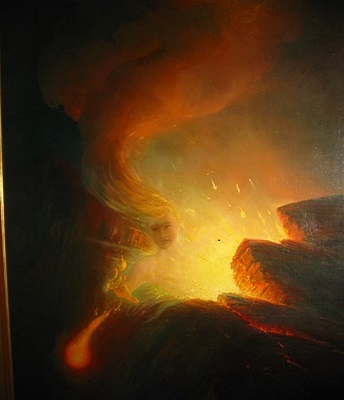Last updated: June 4, 2020
Lesson Plan
Pele’s Journey

- Grade Level:
- Upper Elementary: Third Grade through Fifth Grade
- Subject:
- Science
- Lesson Duration:
- 60 Minutes
- State Standards:
- Hawaiʻi Content and Performance Standards III:
SC.5.2.1 - Additional Standards:
- Next Generation Science Standards:
4-ESS2-2 - Thinking Skills:
- Understanding: Understand the main idea of material heard, viewed, or read. Interpret or summarize the ideas in own words. Analyzing: Break down a concept or idea into parts and show the relationships among the parts.
Essential Question
How does Pele's journey to find a new home compare to the geological formation of the Hawaiian Islands?
Objective
Compare and contrast the lines of evidence supporting the geological formation of the Hawaiian Islands with the cultural perspective as told in ancient Hawaiian legends.
Background
The goddess Pele, with heat and lava at her disposal, is the primary force of Earth building in traditional Hawaiian culture. On each island, Pele uses her digging stick to create fissures and craters. Millions of years of volcanic activity in the middle of the Pacific Ocean has shaped and continues to reshape the landforms of the Hawaiian Islands. This lesson begins with the video (or graphic novel) “Pele Searches for a Home”. It describes the legend of Pele the Hawaiian goddess of fire and her search for a home in these islands. Her journey is a result of the ongoing feud with her sister Nāmaka, forcing her to journey throughout the islands trying to find a safe home. Her route closely mimics the path of the islands geologic formation atop the hot spot in the middle of the Pacific Plate. Like the mountains of lava on which our islands are formed, Pele is continually battling the power of the forces of wind and wave trying to destroy her.
Preparation
Materials Needed:
Internet access for showing video: Pele Searches for a Home
Ages of the Islands Worksheet (included)
Ages of the Islands Teacher Answer Key (included)
Materials
Ages of the Islands Worksheet
Download Ages of the Islands Worksheet
Ages of the Islands Teacher Answer Key
Download Ages of the Islands Teacher Answer Key
Procedure
Step 1: Introduction
Have you ever followed a path, without knowing where it might lead? Have you ever followed in someone’s footsteps down the beach- keeping to exactly the same course they travelled? Today we will follow in the path of lava and volcanic eruption that built the Hawaiian Islands and see what surprise is in store for us on our journey. It is a journey that is still going on! Review with students the movement and direction of the Pacific Plate and the subsequent age of the islands as you look to the northwest in the chain of Hawaiian Islands.
Step 2: Hand out Ages of the Islands Worksheet
Explain Step 1: Instruct students to label each island with its age.
Which Hawaiian Island is the youngest? = Hawaiʻi
Which island is the oldest? = ‘Ni‘ihau
Go over as a class.
Step 3: Watch the video “Pele Searches for a Home” (or Read the graphic novel)
Explain Step 2 on the Ages of the Islands Worksheet. While the students watch the movie, have them number the islands from 1 to 7 in the order of Pele’s journey. Where is her first stop? Use the number 1 for the first island Pele visits to number 7 for the last. Students will need to pay special attention to Pele’s journey throughout the movie. Watch the video “Pele Searches for a Home” which depicts Pele’s travels from Kahiki to Hawai‘i.
Step 4: Discussion
Summarize how Hawaiians explain the formation of the islands (from the video). Think about the 2 different ways the Hawaiian Islands are formed.
Compare and contrast the journey of Pele to the scientific theory of the islands formation.
- How are they similar?
- How are they different?
Vocabulary
Kahiki: Tahiti (may refer to general ancestral lands) or a land far away.
Related Lessons or Education Materials
Adapted from Mattox, S. (1994). A Teacher’s Guide to the Geology of Hawaii Volcanoes National Park. (Activity 3.3). Honolulu, HI: Hawaiʻi Natural History Association.
Adapted from ‘Ōhiʻa Project. (1989). Hot spot! An environmental education guidebook for Hawaiʻi. (pp. 4.5-4.12). Honolulu, HI: Bernice Pauahi Bishop Museum and Moanalua Gardens Foundation.
